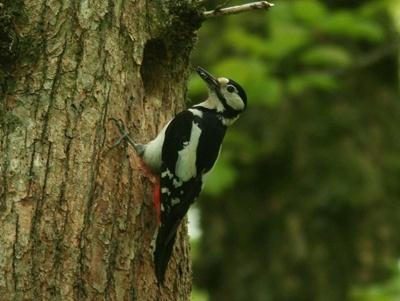First woodpeckers in Irish history spotted

The Great Spotted Woodpecker - known officially as "Dendrocopos majoras" and as "Mórchnagaire breac" in Irish - has recently been sighted in Counties Wicklow and Down, making it the first species of woodpecker ever to settle in Ireland. By Niall Hatch.
When giving talks to group about Ireland’s woodland birds, and especially when using bird identification books and materials designed with a British audience in mind, I used to always insert the caveat, “Of course, we don’t have any woodpeckers in Ireland.”
Though the well-known Great Spotted Woodpecker is a common and widespread woodland and garden resident throughout our neighbouring island (and indeed from the Canary Islands right across to Japan), it was inexplicably absent from Ireland. It was as though St. Patrick’s influence on our snake population had produced knock-on effects on woodpeckers, though a long period of glaciation may have been the real culprit in both cases.
Over the past couple of years, however, the situation has changed. BirdWatch Ireland began to receive an increasing number of phone calls and e-mails concerning strange black-and-white birds visiting back garden bird tables. Shortly afterwards, Great Spotted Woodpeckers were proven to have bred in old-growth woodland in Counties Wicklow and Down and, though still very rare and thinly distributed, it seems that they have gained a breeding toehold here at long last.
Easily recognised by their pied plumage, long wood-boring bill and vertical posture, Great Spotted Woodpecker forage for insect larvae by chipping away at dead wood on trees. They hop vertically up tree trunks using their specially stiffened tail feathers as a prop when searching for invertebrate food; they also enjoy eating the seeds from pine cone, particularly in winter when insects are scarce. They are around 23cm in length, which is about the size of a Blackbird.
In addition to digging out food, the woodpecker’s powerful bill is also used to excavate nest holes, and their drill marks and the loud drumming noises that they make are often the first indicator of their presence. The male has a flash of scarlet on the back of the head, absent on the female, whilst juveniles of both sexes have an all red crown. All ages and sexes also show an obvious patch of red under the tail.
BirdWatch Ireland is asking for the public’s help to track and monitor the spread of these lovely birds, believed to have flown to Ireland due to pressure to find nesting sites caused by recent increases in their population levels in Britain and Scandinavia. Perhaps you have heard a rapid “machine-gun” type rattle when out walking in your local wood, or perhaps you have an unexpected visitor to your garden peanut feeder. If so, e-mail the details to info@birdwatchireland.ie or give us a call at 01-2819878. We would be most grateful.
For more information on the ongoing colonisation of Ireland by this magical bird, you might like to read the following article taken from a recent edition of BirdWatch Ireland’s Wings magazine
Please note: all photographs were taken by Dick Coombes of BirdWatch Ireland under licence from the National Parks and Wildlife Service and may not be reproduced without express prior permission
